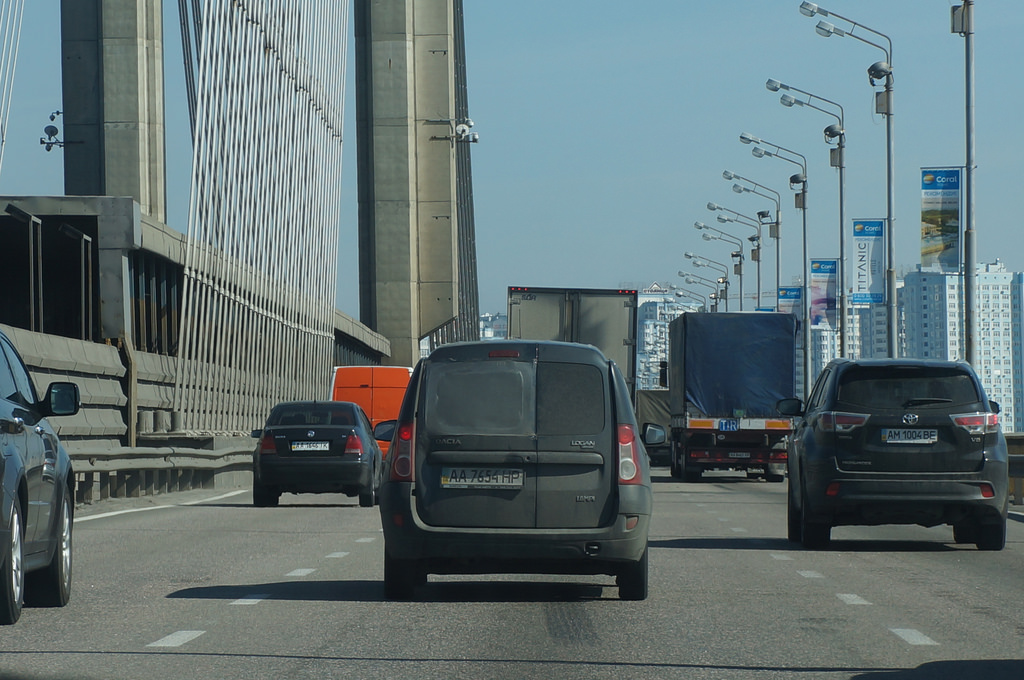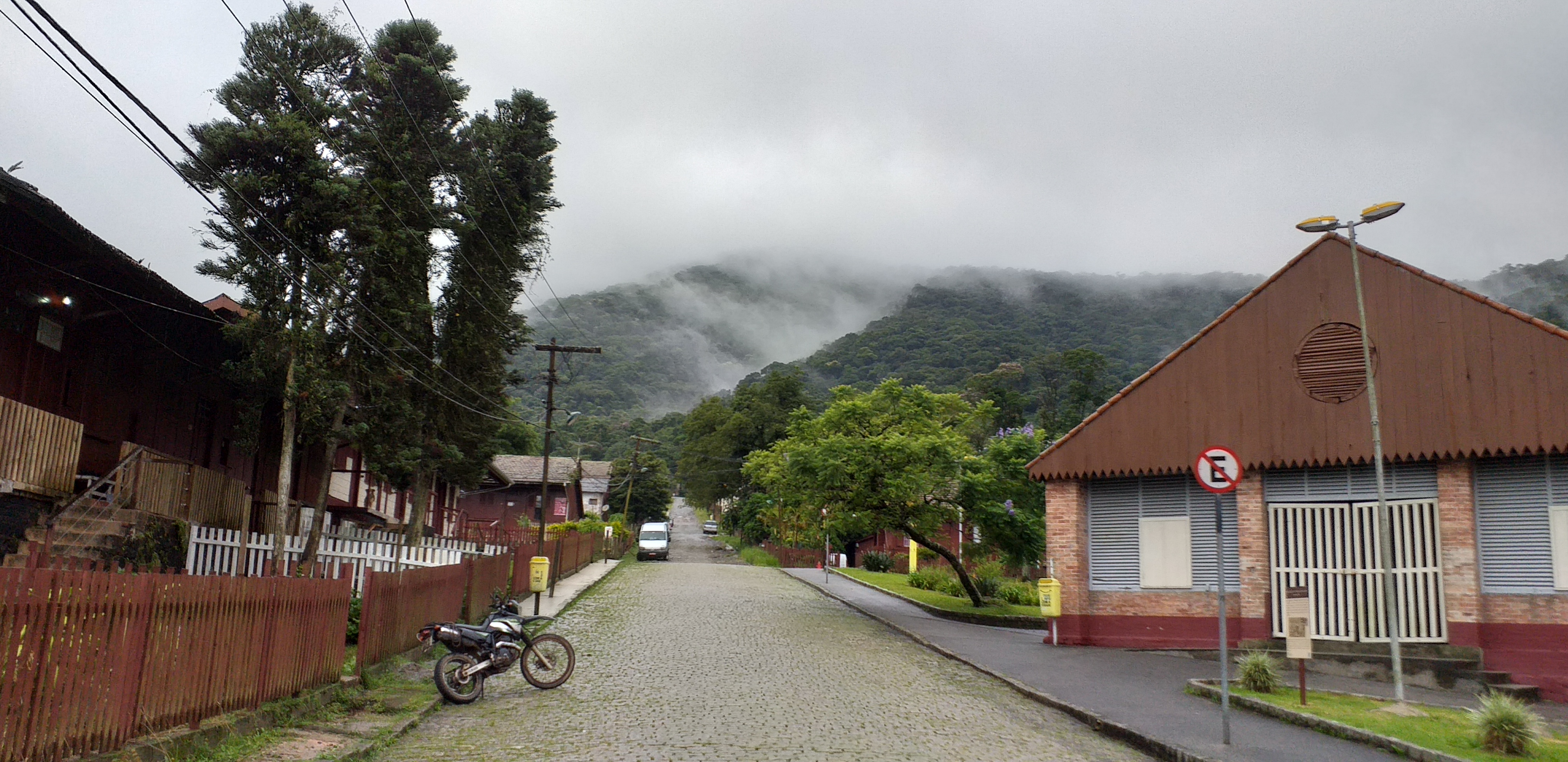|
Pivdennyi Bridge (Kyiv)
The Pivdennyi Bridge ( uk, Південний міст - Southern bridge) in Kyiv, Ukraine was designed by the architect A. Gavrilov ("Mostobud") and a group of engineers headed by G. Fux, was built in 1990. Overview It is the second metro bridge in Kyiv, serving both the Syretsko-Pecherska metro line and road traffic. The cables holding the spans on the bridge are supported by a ferroconcrete double-column pylon in height. The bridge currently has three traffic lanes in both directions (total of six). It connects the Smaller Ring Road around the center of Kyiv. The bridge is part of the / and is formally an extension of the local Promyslova Street. About 1.5 miles north from it is building a new bridge. In 2010 a railway traffic portion of that bridge was finished, while the automobile traffic was scheduled to be established sometime in 2011. The whole project, however, is supposed to end around 2015. See also * Bridges in Kyiv References External links *Bridge profile a ... [...More Info...] [...Related Items...] OR: [Wikipedia] [Google] [Baidu] |
Kyiv Metro
The Kyiv Metro ( uk, Ки́ївський метрополіте́н, Kyivskyi metropoliten, ) is a rapid transit system in Kyiv that is owned by the Kyiv City Council and operated by the city-owned company Kyivsky Metropoliten''.'' It was initially opened on November 6th, 1960, as a single line with five stations. It was the first rapid transit system in Ukraine and the third in the Soviet Union, after the Moscow and St. Petersburg metros. Today, the system consists of three lines and 52 stations, located throughout Kyiv's ten raion (districts), and operates of routes, with used for revenue service and for non-revenue service. At below ground level, Arsenalna station on the Sviatoshynsko-Brovarska Line is the deepest train station in the world. In 2016, annual ridership for the metro was 484.56 million passengers, or about 1.32 million passengers daily. The metro accounted for 46.7% of Kyiv's public transport load in 2014. Beginnings (1884-1920) The first id ... [...More Info...] [...Related Items...] OR: [Wikipedia] [Google] [Baidu] |
Bridges In Kyiv
Kyiv, historically situated on the right bank of the Dnieper River, now covers both banks of the river whose width, as it flows through the city, reaches several hundred metres. Additionally, several tributaries join the Dnieper inside or just north or south of the historic city. Currently there are eight bridges spanning across the river and a few dozen bridges across the canals and Dnieper tributaries. Due to the location and the width of the river, the bridges have always been a very attractive and hard to realize option throughout the long history of Kyiv. Temporary floater bridges were known to have existed since the 12th century. Stationary bridges existed in Kyiv from the mid-19th century, but none of them survived the turbulent events that followed the 1917 Russian Revolution. Early history According to the chronicles, the earliest floating bridge across the Dnieper River in the area was built in the 1115. It was located near Vyshhorod or, according to different ... [...More Info...] [...Related Items...] OR: [Wikipedia] [Google] [Baidu] |
Bridges Over The Dnieper
A bridge is a structure built to span a physical obstacle (such as a body of water, valley, road, or rail) without blocking the way underneath. It is constructed for the purpose of providing passage over the obstacle, which is usually something that is otherwise difficult or impossible to cross. There are many different designs of bridges, each serving a particular purpose and applicable to different situations. Designs of bridges vary depending on factors such as the function of the bridge, the nature of the terrain where the bridge is constructed and anchored, and the material used to make it, and the funds available to build it. The earliest bridges were likely made with fallen trees and stepping stones. The Neolithic people built boardwalk bridges across marshland. The Arkadiko Bridge (dating from the 13th century BC, in the Peloponnese) is one of the oldest arch bridges still in existence and use. Etymology The ''Oxford English Dictionary'' traces the origin of the wo ... [...More Info...] [...Related Items...] OR: [Wikipedia] [Google] [Baidu] |
Road Bridges In Kyiv
A road is a linear way for the conveyance of traffic that mostly has an improved surface for use by vehicles (motorized and non-motorized) and pedestrians. Unlike streets, the main function of roads is transportation. There are many types of roads, including parkways, avenues, controlled-access highways (freeways, motorways, and expressways), tollways, interstates, highways, thoroughfares, and local roads. The primary features of roads include lanes, sidewalks (pavement), roadways (carriageways), medians, shoulders, verges, bike paths (cycle paths), and shared-use paths. Definitions Historically many roads were simply recognizable routes without any formal construction or some maintenance. The Organization for Economic Co-operation and Development (OECD) defines a road as "a line of communication (travelled way) using a stabilized base other than rails or air strips open to public traffic, primarily for the use of road motor vehicles running on their own wheels", whic ... [...More Info...] [...Related Items...] OR: [Wikipedia] [Google] [Baidu] |
Railroad Bridges In Kyiv
Rail transport (also known as train transport) is a means of transport that transfers passengers and goods on wheeled vehicles running on rails, which are incorporated in tracks. In contrast to road transport, where the vehicles run on a prepared flat surface, rail vehicles (rolling stock) are directionally guided by the tracks on which they run. Tracks usually consist of steel rails, installed on sleepers (ties) set in ballast, on which the rolling stock, usually fitted with metal wheels, moves. Other variations are also possible, such as "slab track", in which the rails are fastened to a concrete foundation resting on a prepared subsurface. Rolling stock in a rail transport system generally encounters lower frictional resistance than rubber-tyred road vehicles, so passenger and freight cars (carriages and wagons) can be coupled into longer trains. The operation is carried out by a railway company, providing transport between train stations or freight customer facili ... [...More Info...] [...Related Items...] OR: [Wikipedia] [Google] [Baidu] |
Kaniv Hydroelectric Power Plant
Kaniv Hydroelectric Power Plant is a hydroelectricity generating complex on the Dnieper River in Kaniv, Ukraine. It is operated by the Ukrhydroenego that is part of the state company Energy Company of Ukraine. The power plant was projected by the Ukrainian department of project-research institute "UkrHydroProject" of S.Zhuk. The construction was conducted by several specialized in this field companies. During the construction also there was built a small settlement for the power plant's working personnel. Turbines for the plant were produced by the Kharkiv Factory " Turboatom", generators - Kharkiv Factory "Elektrovazhmash". The dam has a lock to allow water travel along the Dnieper river. It is a single-stage, a single chamber lock. The lock's size is . History In 1997, the Kaniv Hydroelectric Power Plant started to be renovated. The first stage lasted until June 2002, while the second one - 2017. The first stage was financed through the IBRD, while the second World Bank invest ... [...More Info...] [...Related Items...] OR: [Wikipedia] [Google] [Baidu] |
New Darnytskyi Bridge
The New Darnytskyi Bridge () is a combined road and railroad bridge in Kyiv, the capital of Ukraine. It spans across the Dnieper River connecting the left and right banks of the city, the Darnytsia and Holosiiv districts of Kyiv, respectively. The bridge carries a double track rail line and is built to accommodate six lanes of road traffic. The bridge was completed in July 2023, but operated in reduced capacity for months before, lacking road connection ramps from ''some'' directions. Additional railroad links to match the new bridges' capacity are also being constructed. The bridge's expected capacity is 60,000 vehicles and 120 pairs of trains per day, which will serve as a major relief for both the Kyiv road and bridge network and as well as Ukraine's Ukrzaliznytsia national rail system. Location and design The new bridge was built north of the existing Darnytskyi Railroad Bridge. History The bridge construction is the initiative of the late Heorhiy Kirpa, the head of U ... [...More Info...] [...Related Items...] OR: [Wikipedia] [Google] [Baidu] |
Highway M03 (Ukraine)
Highway M03 is a Ukrainian international highway ( M-highway) connecting Kyiv with Dovzhansky on the border with Russia, where it continues into Russia as the A270. It is part of European route E40 from Kyiv to Debaltseve at which it is part of European route E50 to the border with Russia. At , the M03 is the longest international state highway in Ukraine. In Soviet times the M03 was part of the M19. Today, the highway stretches through five oblasts and ends at the border checkpoint at Dovzhansky which is part of Sverdlovsk Raion (Luhansk Oblast). The route connects Kyiv and Kharkiv with the industrial region of Donbass. Part of the M03 between Kyiv and Boryspil was reconstructed into an automagistral to handle higher traffic between Kyiv and the Boryspil International Airport. From Boryspil to Lubny, the road is a dual carriageway, thereon it continues as a single carriageway with some 2x2 sections. Significant armed conflict has occurred on or near the eastern portions ... [...More Info...] [...Related Items...] OR: [Wikipedia] [Google] [Baidu] |
Dnieper River
} The Dnieper () or Dnipro (); , ; . is one of the major transboundary rivers of Europe, rising in the Valdai Hills near Smolensk, Russia, before flowing through Belarus and Ukraine to the Black Sea. It is the longest river of Ukraine and Belarus and the fourth- longest river in Europe, after the Volga, Danube, and Ural rivers. It is approximately long, with a drainage basin of . In antiquity, the river was part of the Amber Road trade routes. During the Ruin in the later 17th century, the area was contested between the Polish–Lithuanian Commonwealth and Russia, dividing Ukraine into areas described by its right and left banks. During the Soviet period, the river became noted for its major hydroelectric dams and large reservoirs. The 1986 Chernobyl disaster occurred on the Pripyat, immediately above that tributary's confluence with the Dnieper. The Dnieper is an important navigable waterway for the economy of Ukraine and is connected by the Dnieper ... [...More Info...] [...Related Items...] OR: [Wikipedia] [Google] [Baidu] |
European Route E40
European route E40 is the longest European route, more than long, connecting Calais in France via Belgium, Germany, Poland, Ukraine, Russia, Kazakhstan, Uzbekistan, Turkmenistan, and Kyrgyzstan, with Ridder in Kazakhstan near the border with Russia and China. A different route connecting Calais and Ridder is about shorter, mostly using the E30 via Berlin-Moscow-Omsk. The E40 differs from that route in order to provide additional direct east-west access to Uzbekistan, Turkmenistan, and Kyrgyzstan, which have a combined population base approaching 50 million people as of 2021. Route France *: Calais ( E15 / E402) - Dunkirk - Ghyvelde Belgium *: Adinkerke - Veurne - Jabbeke ( E404) *: Jabbeke ( E404) - Bruges ( E403) - Gent ( E17) - Brussels ( E19) *: Brussels ( E19 Towards E411) *: Brussels - Leuven ( E314) - Liège ( E25 / E42 / E313, Towards E46) - Verviers ( E42) - Lichtenbusch ( E421) Germany *: Aachen ( E 314) *: Aachen ( E 314) - Cologne ( E 31 / E ... [...More Info...] [...Related Items...] OR: [Wikipedia] [Google] [Baidu] |


.jpg)


